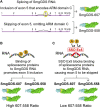SmgGDS: An Emerging Master Regulator of Prenylation and Trafficking by Small GTPases in the Ras and Rho Families
- PMID: 34222337
- PMCID: PMC8242357
- DOI: 10.3389/fmolb.2021.685135
SmgGDS: An Emerging Master Regulator of Prenylation and Trafficking by Small GTPases in the Ras and Rho Families
Abstract
Newly synthesized small GTPases in the Ras and Rho families are prenylated by cytosolic prenyltransferases and then escorted by chaperones to membranes, the nucleus, and other sites where the GTPases participate in a variety of signaling cascades. Understanding how prenylation and trafficking are regulated will help define new therapeutic strategies for cancer and other disorders involving abnormal signaling by these small GTPases. A growing body of evidence indicates that splice variants of SmgGDS (gene name RAP1GDS1) are major regulators of the prenylation, post-prenylation processing, and trafficking of Ras and Rho family members. SmgGDS-607 binds pre-prenylated small GTPases, while SmgGDS-558 binds prenylated small GTPases. This review discusses the history of SmgGDS research and explains our current understanding of how SmgGDS splice variants regulate the prenylation and trafficking of small GTPases. We discuss recent evidence that mutant forms of RabL3 and Rab22a control the release of small GTPases from SmgGDS, and review the inhibitory actions of DiRas1, which competitively blocks the binding of other small GTPases to SmgGDS. We conclude with a discussion of current strategies for therapeutic targeting of SmgGDS in cancer involving splice-switching oligonucleotides and peptide inhibitors.
Keywords: GDF; GEF; Rap1GDS1; SmgGDS; lipidation; prenylation; splicing; trafficking.
Copyright © 2021 Brandt, Koehn and Williams.
Conflict of interest statement
The authors declare that the research was conducted in the absence of any commercial or financial relationships that could be construed as a potential conflict of interest.
Figures




Similar articles
-
GTPase splice variants RAC1 and RAC1B display isoform-specific differences in localization, prenylation, and interaction with the chaperone protein SmgGDS.J Biol Chem. 2023 Jun;299(6):104698. doi: 10.1016/j.jbc.2023.104698. Epub 2023 Apr 12. J Biol Chem. 2023. PMID: 37059183 Free PMC article.
-
Splice variants of SmgGDS control small GTPase prenylation and membrane localization.J Biol Chem. 2010 Nov 12;285(46):35255-66. doi: 10.1074/jbc.M110.129916. Epub 2010 Aug 13. J Biol Chem. 2010. PMID: 20709748 Free PMC article.
-
Splice switching an oncogenic ratio of SmgGDS isoforms as a strategy to diminish malignancy.Proc Natl Acad Sci U S A. 2020 Feb 18;117(7):3627-3636. doi: 10.1073/pnas.1914153117. Epub 2020 Feb 4. Proc Natl Acad Sci U S A. 2020. PMID: 32019878 Free PMC article.
-
The polybasic region of Ras and Rho family small GTPases: a regulator of protein interactions and membrane association and a site of nuclear localization signal sequences.Cell Signal. 2003 Dec;15(12):1071-80. doi: 10.1016/s0898-6568(03)00098-6. Cell Signal. 2003. PMID: 14575862 Review.
-
Protein prenylation and synaptic plasticity: implications for Alzheimer's disease.Mol Neurobiol. 2014 Aug;50(1):177-85. doi: 10.1007/s12035-013-8627-z. Epub 2014 Jan 5. Mol Neurobiol. 2014. PMID: 24390573 Free PMC article. Review.
Cited by
-
Protein lipidation in cancer: mechanisms, dysregulation and emerging drug targets.Nat Rev Cancer. 2024 Apr;24(4):240-260. doi: 10.1038/s41568-024-00666-x. Epub 2024 Feb 29. Nat Rev Cancer. 2024. PMID: 38424304 Review.
-
ICP4-Associated Activation of Rap1b Facilitates Herpes Simplex Virus Type I (HSV-1) Infection in Human Corneal Epithelial Cells.Viruses. 2023 Jun 27;15(7):1457. doi: 10.3390/v15071457. Viruses. 2023. PMID: 37515145 Free PMC article.
-
Structural and biophysical properties of farnesylated KRas interacting with the chaperone SmgGDS-558.Biophys J. 2022 Oct 4;121(19):3684-3697. doi: 10.1016/j.bpj.2022.05.028. Epub 2022 May 25. Biophys J. 2022. PMID: 35614853 Free PMC article.
-
Novel regulatory roles of small G protein GDP dissociation stimulator (smgGDS) in insulin secretion from pancreatic β-cells.Mol Cell Endocrinol. 2024 Jan 15;580:112104. doi: 10.1016/j.mce.2023.112104. Epub 2023 Oct 30. Mol Cell Endocrinol. 2024. PMID: 38013223 Free PMC article.
-
M6A modification regulates tumor suppressor DIRAS1 expression in cervical cancer cells.Cancer Biol Ther. 2024 Dec 31;25(1):2306674. doi: 10.1080/15384047.2024.2306674. Epub 2024 Feb 19. Cancer Biol Ther. 2024. PMID: 38372700 Free PMC article.
References
-
- Ando S., Kaibuchi K., Sasaki T., Hiraoka K., Nishiyama T., Mizuno T., et al. (1992). Post-translational Processing of Rac P21s Is Important Both for Their Interaction with the GDP/GTP Exchange Proteins and for Their Activation of NADPH Oxidase. J. Biol. Chem. 267 (36), 25709–25713. 10.1016/s0021-9258(18)35665-5 - DOI - PubMed
Publication types
Grants and funding
LinkOut - more resources
Full Text Sources

